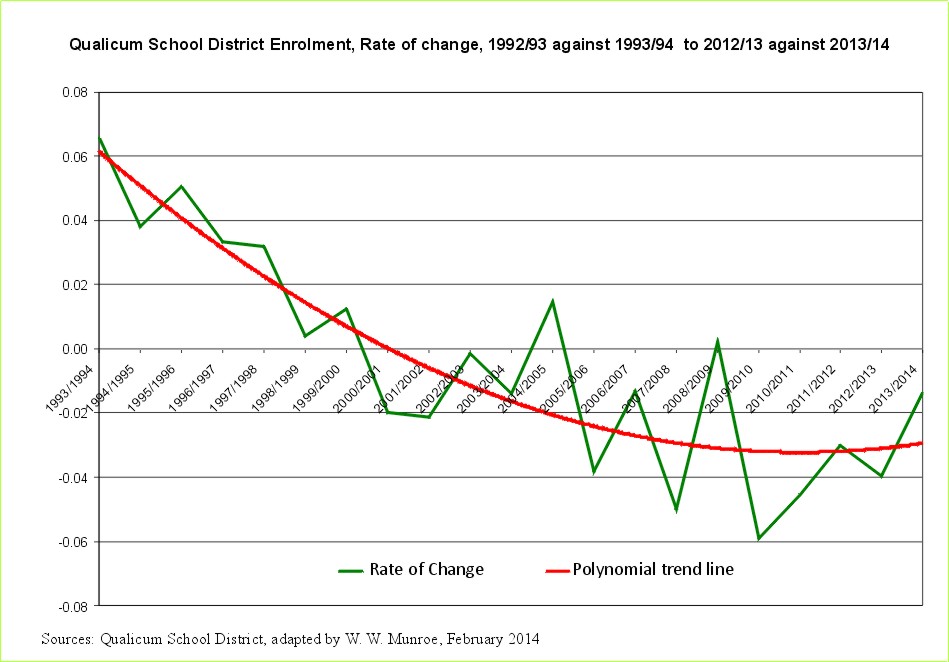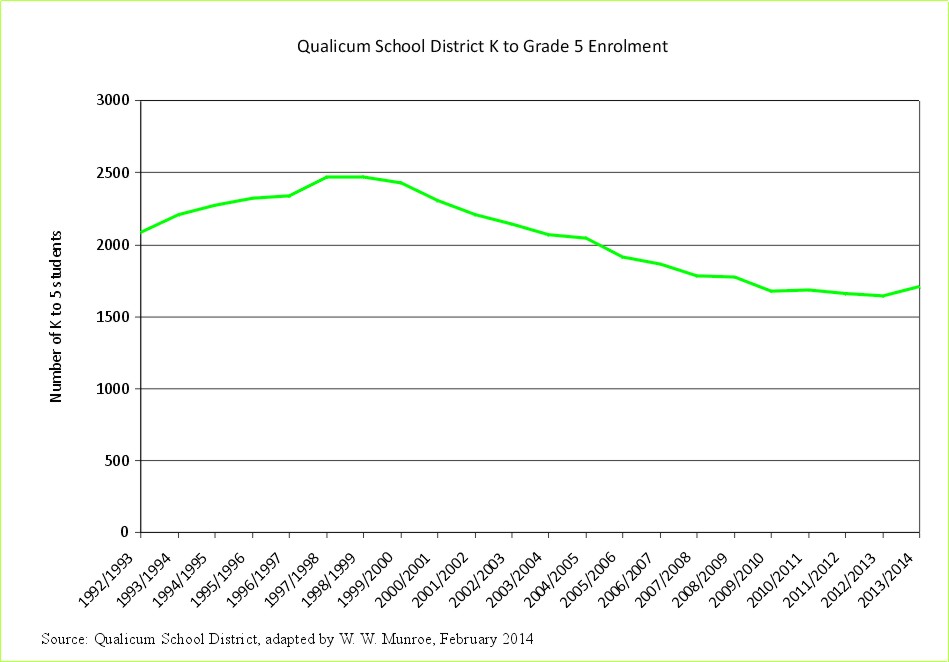The Qualicum School District's last facility review in 2010 included BC Statistics' false reporting of methods used to create population numbers. The method provided by BC Statistics did not show that BC Statistics used the change in the number of telephone lines as an indicator of population change, nor the many other influences on the final numbers. For this most recent facility review (2013-14), methods are simply not provided.

In response to requests to the Ministry responsible for BC Statistics about why the methods provided in the 2010 Qualicum School District's (QSD) Facility Review (recommending closing the only high school in Qualicum Beach just 7 years after opening a $9.1 million expansion) were not the methods used to create the population estimates and projections for the area, a government representative replied that BC Statistics methods are better than Statistics Canada's.
Oh, really?

How could using the change in the number of telephone landlines be considered better? The many requests for the report, or at least the title, claiming BC Statistics methods are better were ignored and a freedom of information request was denied claiming:
What? Disclosure of the report done by Statistics Canada stating that BC Stats' population estimates were found to be better than Statistics Canada's is considered "harmful to interprovincial negotiations and relations." One reader commented: "something stinks in the BC Government."
Thankfully, Statistics Canada did provide the report Conclusions of Finance Canada"The Equalization Program and the Property Tax Base: Feasibility Study Conducted by Statistics Canada". This feasibility study was conducted from May 2004 to February 2005.

The report to Finance Canada submitted by Statistics Canada shows that BC Statistics' Directors did not inform Statistics Canada about the use of telephone landlines (Telus) purchased and adopted since the year 2000, and instead claimed to be using the 1998 method - the same incorrect method provided for the Qualicum School District in 2010. The report also shows that BC Statistics' Directors falsified the amount of error (over 6%) between their method and the census results (claiming the error was less than 2%) (page 63).
To be clear, BC Statistics provided false reports to BC's School Districts addressing school closures (nearly 200 between 2001 and 2011) as well as false reports to Statistics Canada for the assessment of methods for the Equalization Program. Just like parents/guardians and concerned citizens, Statistics Canada did not verify that the correct method accompanied the population numbers, but rather, accepted BC Statistics' false information in good faith. Were there other reasons to withhold Statistics Canada's report claiming "Disclosure harmful to interprovincial negotiations and relations."
While serving as the Population Analyst for BC Statistics from January 2002 to February 2006, I regularly asked at section meetings that the new methods (using Telus data) be published. Eventually, under new management, I was not invited to section meetings, removed from all responsibility, removed from the contacts list, followed by accusations that I made my co-workers fear for their safety. My many requests for mediation were ignored and the resolution to my grievance (requesting mediation to address what behaviour made my co-workers fear for their safety?) was that there would be "no resolution" (Executive Director of BC Statistics, Don McRae, December 12, 2005).
Shortly after forwarding my grievance to the Deputy Minister, Gordon Macette, January 30, 2006, I was ordered by the Population Section manager, Dave O'Neil, to gather my belongings and "escorted" out of the BC Statistics building with the shop steward (Marvin Paxman) carrying some of my books. A week later I was ordered to return to work and required to submit to an assessment of a "believed" "behavioural problem". For continuing to insist on mediation and that the correct methods be published instead, I was dismissed for "insubordination" by the Deputy Minister Gordon Macette.
Gordon Macette had authorized Don MacRae's request to change the job posting for the position of manager of the Population Section from open to all Canadians to restricted to only BC Statistics personnel thus ensuring Dave O'Neil who was the acting manager would get the job.
My many requests for arbitration have been denied. I only found out in 2012 that Dave O'Neil, Don McRae, and Gordon Macette had provided false reports for Statistics Canada's 2005 Equalization Program Feasibility Study. Little wonder, so many elected representatives resigned after 2006, including the Minister of Labour and Citizens' Service, Olga Ilich shortly after writing to me in 2008, and why Premier Clark described British Columbia's Capital as having a "sick culture" in May 2012.
In September 2013, the new Assistant Deputy Minister, Angelo Cocco restated the same assertion made by Betty Jo Hughes that "the integrity and objectivity of the population estimation methods and process are safeguarded by BC Stats." adding "we do not see value in continuing to respond to enquiries of a similar nature" Sincerely, Angelo Cocco.
Integrity means complete, undivided; therefore the correct methods must accompany the "findings"; otherwise, people who do not provide the methods and data, such as Dave O'Neil, Don McRae, and Gordon Macette, demonstrate a lack integrity.
As mentioned, if you can not see the methods and data, if you are not allowed to verify the numbers used to justify decision making regarding public issues, there is no integrity; therefore, do not use those numbers - use alternatives that are open, transparent, and can be validated.3
For well defined population projections scenarios based on current trends (following Statistics Canada's steps to "safeguard integrity") refer to the Population Projection Project.
1 See the summary of the presentation at the 2013 Congress Methods for Projections session hosted by the Canadian Population Society.
2 Letter authored by Assistant Deputy Minister for Service BC, Betty-Jo Hughes, at the request of Dr. Margaret MacDiarmid, the Minister of Labour, Citizens' Services' and Open Government, page 1, page 2.
3 To see how Statistics Canada addresses formal policies and clear accountabilities to address the "intrinsic risks" lurking in statistical agencies read Statistics Canada's steps to "safeguard integrity"
The Difference between Projections and Forecasts
Qualicum School District "Facility Review Process" November 2013 at www.sd69.bc.ca/Publications/Facility%20Review%202013%20-%20Finance%20and%20Facility%20Planning/13.11.26%20Facilities%20Review%20Presentation.pdf


